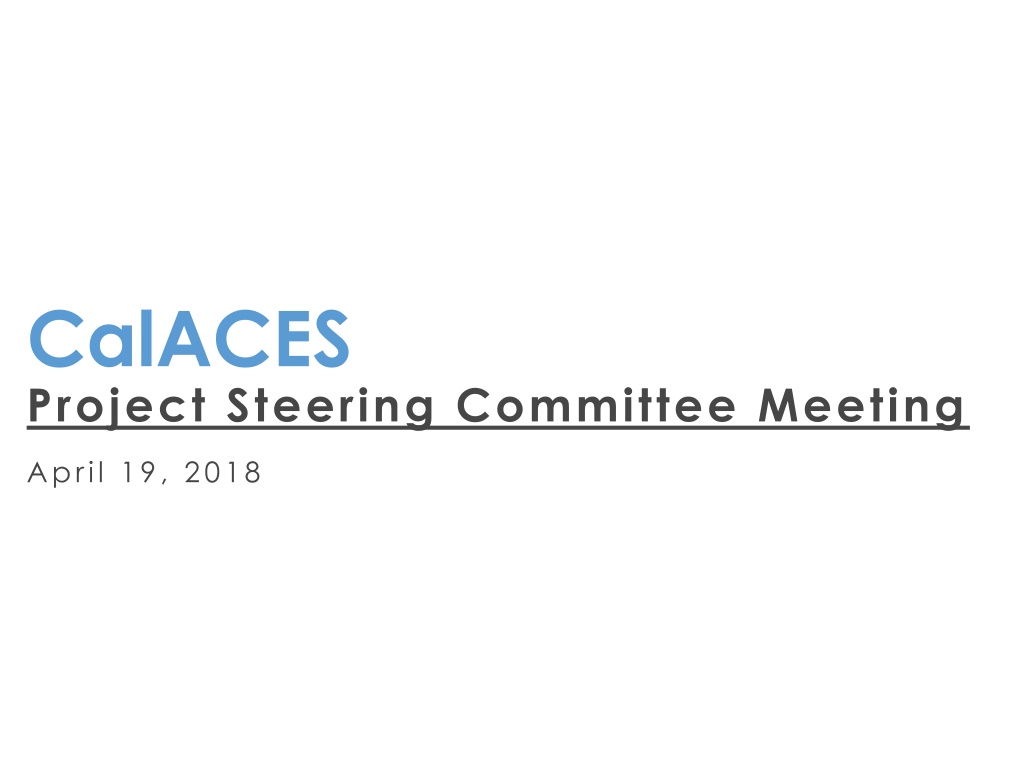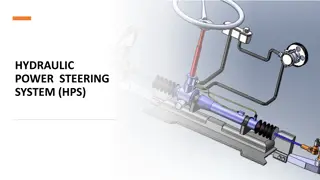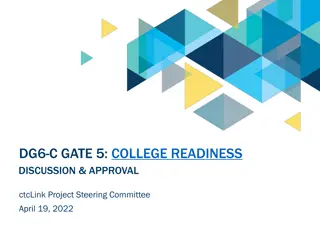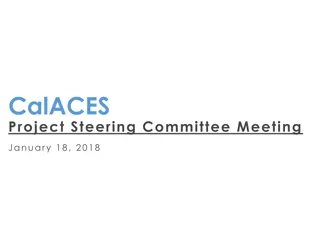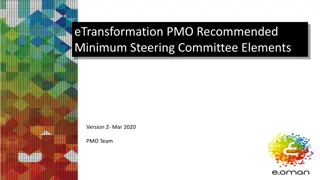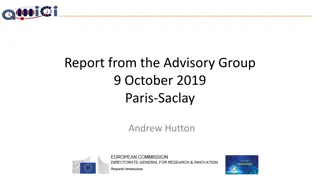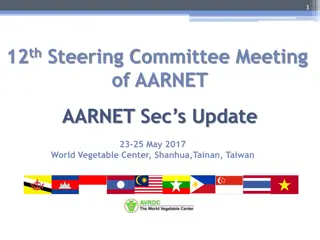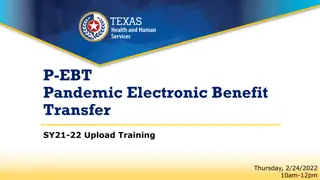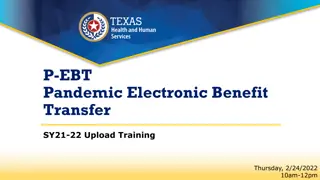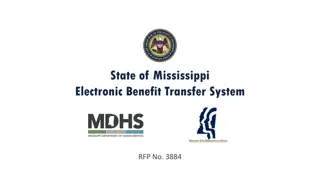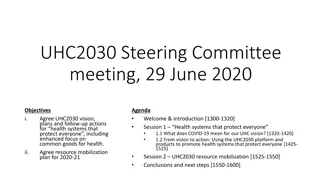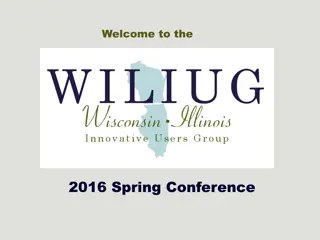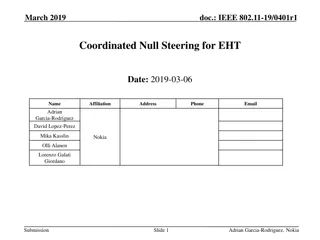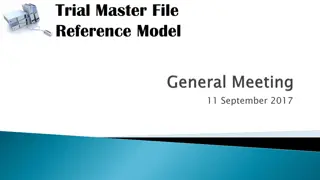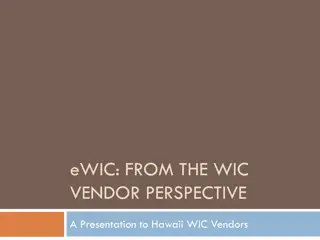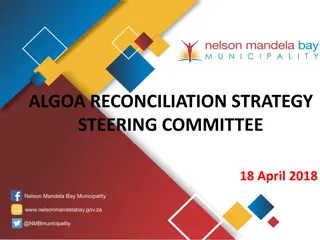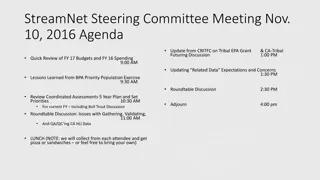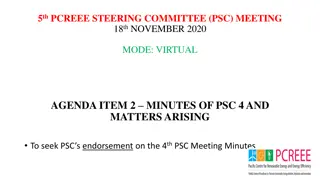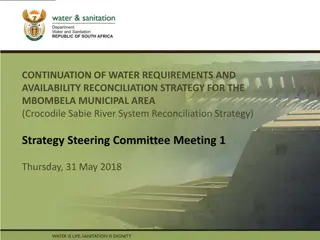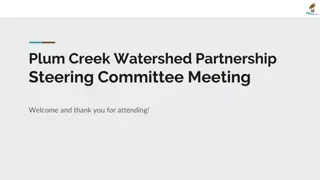Project Steering Committee Meeting Updates and EBT Implementation Progress
Updates from the CalACES Project Steering Committee meeting on April 19, 2018, including agenda items, approval of minutes, and logo recommendations. Additionally, details on the Electronic Benefit Transfer (EBT) Project implementation progress, high-level timeline, testing schedule, FNS certification, cutover preparation, consortia communication, county communications, and cardholder communication strategies leading up to the upcoming changes.
- Meeting Updates
- Project Steering Committee
- EBT Implementation
- Communication Strategies
- Progress Updates
Download Presentation

Please find below an Image/Link to download the presentation.
The content on the website is provided AS IS for your information and personal use only. It may not be sold, licensed, or shared on other websites without obtaining consent from the author. Download presentation by click this link. If you encounter any issues during the download, it is possible that the publisher has removed the file from their server.
E N D
Presentation Transcript
CalACES Project Steering Committee Meeting April 19, 2018
CalACES PSC Agenda 1) Call Meeting to Order 2) Agenda Review 3) Public opportunity to speak on items not on the Agenda 2
CalACES PSC Action Items 4) Approve the Minutes of the March 15, 2018 Project Steering Committee Meeting and review of Action Items 5) Approve CalACES Logo recommendations for submittal to the JPA Board 3
Electronic Benefit Transfer (EBT) Project EBT Implementation Update April 19, 2018
EBT Implementation High Level Timeline Testing UAT scheduled to complete April 27th FNS Certification May 1st - May 3rd Cutover Preparation Cutover Weekend Post-Cutover Support Page 2 of 6
Consortia Communication April 2018 Consortia cutover kickoff meetings. Eligibility system network certification (Final) May 2018 Ongoing bi-weekly meetings (Consortia, OSI, FIS, Conduent) Eligibility system readiness verification June 2018 Communication matrix for cutover weekend distributed Cutover weekend checkpoint meetings Page 3 of 6
County Communications The transition team has been engaged with counties since the Spring of 2017. A part of this engagement includes: Creation of County specific transition workplans. County-developed communication plans County Newsletters/County Transition Meetings April 2018 CDSS sends ACL to counties regarding Client Outage Notice May / June 2018 County System Training Train the Trainer Counties execute communications plan for staff and stakeholders County Readiness Assessment Two weeks before cutover Counties advised to educate new and immediate need clients regarding EBT outage Page 4 of 6
Cardholder Communication April 2018 State identifies active cardholders to receive client outage notification (18 languages) May 2018 Counties to place copies of the outage notice in their issuing offices June 2018 Active cardholders (as of April 30) receive mailed outage notice Cutover Weekend Beginning 11pm Saturday, June 23rd, the Cardholder ARU provides a message indicating services are unavailable. Note: Stakeholders and Retailers have been previously notified of the EBT outage. Page 5 of 6
Cutover Weekend Who to call list to be provided if counties are experiencing unexpected issues. Eligibility systems to send final batch files for new accounts and benefits by Friday, June 22nd at 8PM EBT functions at county offices unavailable Saturday, June 23rd and Sunday, June 24th. FIS Equipment Changeover Network Re-confirm FIS network connectivity Printers - Retest/re-confirm printing capability from eligibility systems PIN Pad / BIO Devices Swap / Test / Re-confirm Systems Access Re-confirm access to new FIS systems Page 6 of 6
Review April 10th Special JPA Board Meeting Contents
Draft: Governance MOU between CalACES and WCDS Please turn to the following handout: 8-1 DRAFT Gov ernance MOU between CalACES and WCDS 041018 v 2.docx
CalACES PSC Agenda 1) 2) 3) 4) 5) CalACES-CalSAWS Progress CalACES-CalSAWS Planning Timeline CalSAWS User Labs Update Requirements Gathering Status CalSAWS Executive Leadership Team Update 15
CalACES PSC CalACES-CalSAWS Progress The PAPDU has been updated to support a larger overall effort and additional concurrent activities in support of CalSAWS CalWIN and CalACES have planned contract amendments/change orders to accommodate additional services by the 3rd Party Independent Contractor Approval of the additional change order for CalACES is planned for the April 26, 2018 JPA meeting Review and approval of the CalWIN change order is planned for April 13, 2018 # Key Task Conduct CalACES Alternatives Analysis and Cost Benefit Analysis CalWIN/CalSAWS Requirements Analysis CalWIN/CalSAWS Business Process Gap Analysis CalWIN Ancillary Systems Analysis CalWIN/CalSAWS Data Conversion Strategy CalWIN Initial Data Mapping Contract CalACES First Data (Current) 1. CalACES First Data 2. 3. CalWIN Infosys 4. CalWIN Infosys CalACES First Data 5. 6. CalWIN - Infosys 16
CalACES PSC CalACES-CalSAWS Planning Project Progress Task Description Status Hosting strategy identified as government cloud Additional analysis in progress Analyze options for CalACES hosting strategy Analyze options for CalACES datacenter consolidation Analyze options for CalACES database consolidation Analyze options for SAWS Shared Services e.g. Single SAWS Consolidated Portal Conduct CalACES Alternatives Analysis and Cost Benefit Analysis 1 User labs in progress Requirements sessions being planned Plan Requirements Assessment Conduct CalSAWS User Labs Facilitate Requirements Sessions Assess Impact of Alternatives Analysis and Update Requirements (Existing & New) CalWIN/CalSAWS Requirements Analysis 2 Document As-Is and To-Be Business Processes Compare CalWIN Functionality to CalACES/CalSAWS Functionality Document Gaps in Business Processes and Identify Requirements to Address Gaps Determine Impact of New Requirements Update Existing Requirements Kick off meeting planned Information gathering in process CalWIN/CalSAWS Business Process Gap Analysis 3 17
CalACES PSC CalACES-CalSAWS Planning Project Progress Task Description Status Kick off meeting planned Information gathering in process Complete Inventory Request Complete Targeted Demonstrations Identify Essential Functionality & Gaps Update Requirements CalWIN Ancillary Systems Analysis 4 Kick off meeting planned Gather CalWIN Database Information Analyze Preliminary Data Mapping Document Conversion Strategy Options CalWIN/CalSAWS Data Conversion Strategy 5 Compare Database Table & Elements between CalWIN & CalACES Identify Required Core Tables & Elements Document Initial Data Mapping Kick off meeting planned CalWIN Initial Data Mapping 6 18
CalACES PSC CalACES-CalSAWS Planning Timeline CalACES-CalSAWS Planning January February March April May June July August September October November December + LRS Cloud Enablement Begins 7/1/18 Technical Analysis (Step 1 - Cloud, Database, Data Center, Portal) 1/19/18 - 3/28/18 Technical Analysis (Step 2 - Ancillary, Shared Services) 3/14/18 - 5/25/18 1 CalACES/CalSAWS Implementation Advance Planning Document and Updates 6/18/18 1/2/19+ CalWIN/CalSAWS Requirements Planning & Analysis 2/1/18 6/26/18 2 Update Statement of Requirements 6/25/18 - 7/3/18 Plan Requirements Analysis 2/1/18 - 3/16/18 North-South User Labs 3/15/18 - 5/11/18 Requirements Gathering Sessions 5/14/18 - 6/26/18 3 CalWIN Business Process & Ancillary Systems Analysis 3/26/18 6/29/18 4 CalACES Migration Begins 1/3/19 CalWIN/CalSAWS Data Conversion Strategy 5/7/18 6/22/18 CalWIN Initial Data Mapping 6/25/18 8/13/18 5 6 Acquisition Strategy 4/9/18 5/11/18 Non-Competitive & Competitive Acquisition 5/1/18 11/30/18 Cloud Service Contracting/ Acquisition 4/16/18 6/22/18 Complete Process Alignment, Change Control, Project Readiness 19
CalSAWS User Lab Updates Week 1 Eligibility CalWORKs/CalFresh Focus - (As of Wednesday EOB) CalACES PSC Challenges & Status Technical Issues User Log Ins Process change initiated Security Issues Pending resolution for topic weeks Training Validations - Resolved Operational Changes Additional Roamers needed in the North - Resolved Documentation Capture all comment forms and debrief feedback in a central spreadsheet Parking lot forms have written response, shared with user lab participants and captured on the central spreadsheet 20
CalACES PSC CalSAWS User Labs Week 1 (As of Wednesday EOB) Lessons Learned Update process and validate that all security forms have been received and C Numbers so that everybody has a login in day one More roamers in the North Shortening the Project Logistics slide deck in the South Reduce background information in Orientation Slide Deck and reduce overall detail to shorten the time Do quicker and higher level demos Hold questions during the demo until the end Improvements Week 2 - Log In issues were resolved within hours Orientation overview was completed prior to User Lab by CalWIN Project Staff Orientation and demonstrations were completed much quicker on day one Additional staff available for roaming in the North 21
CalACES PSC CalSAWS User Lab Overview CalSAWS User Labs Comment Form and Parking Lot Form Tracking All comment forms and parking lot forms will be documented in a tracking spreadsheet Staff will document all potential gaps and the gaps will be reviewed in Phase 3, Requirements Gathering Sessions CalSAWS Tracking Spreadsheet Categorize all items into 4 categories: Design Difference Identified Existing CalACES Requirement Suggested Enhancement Duplicate 22
CalACES PSC CalSAWS User Labs Outcomes User Lab Comments Existing Requirements Design Difference Identified Suggest Enhancement N/A Totals North South 36 24 14 5 79 38 28 26 6 98 Each comment was categorized into one of four categories: Existing Requirements: Have an existing requirement and User Lab Participant is indicating a status change in the indicator as defined from the CalWIN Project Review Design Difference Identified: A gap has been identified as a difference between LRS and CalWIN that affects efficiency or functionality Suggest Enhancement: CalWIN Participants have identified a suggested enhancement* to the system *Note: Identified as an enhancement by Migration Planning Team and must be reviewed by CalWIN Project N/A: These have been identified as Not Applicable due to being retracted by the User or an environment issue and it is not really a gap. Note: There were 72 items across North/South that were determined to be duplicates of the items above. 23
CalACES PSC CalSAWS User Labs Outcomes Explanation Positive Comments Immunizations functionality, Verifications List Page, Message Center, Address Pre- Population functionality during case creation, Task Navigation for easier access to specific pages, Codes on Citizenship page, Hide Person functionality, Universal Journal Template, Relationship Page, ICT process including images, Itemized Deductions in EDBC No Workflow, Display reasons for failing EDBC, Application Registration, Expedited Services/Immediate Need, FPL information not on EDBC, Medi-Cal behind the scenes evaluation for eligibility for other programs, Employment information in multiple places, Journal displays vertically Change Management Concerns 24
CalACES PSC CalSAWS Guided Requirements Gathering Sessions When May 14 June 22 (6 weeks) Sessions scheduled by specific topic area Each topic expected to be no more than 1 week Number of sessions to be determined Participants Attendance 40 CalACES (5 per Region) and 40 CalWIN (2 per county) plus Project and State Staff County Staff should be able to make decisions for the counties they represent and ideally will have participated in the user lab sessions Recruiting Process: CalWIN-CalACES CRFI Travel costs will be covered (but not staff time) Each participant would be expected to attend 1 or more sessions Output Updated statement of requirements to be presented to the stakeholders 25
CalACES PSC CalSAWS Executive Leadership Team Update Governance Planning In Progress Agreed to form a JPA between CalWIN and CalACES Identified tasks to develop the JPA Agreement Working on Schedule Drafted a Memorandum of Understanding (See Attachment) 26
CalACES SCR: Requirements & Design Process
CalACES PSC CalACES SCR Process Background: Consortium staff have received questions regarding region input into the SCR process and a request for information on the SCR Planning Group process. The following slides provide information on: CalACES Region-Project collaboration during the SCR process SCR Planning Group SPG process 28
CalACES PSC CalACES SCR Process CalACES Region-Project Collaboration Region-Project Collaboration Draft County Enhancement request Region ACL Input Regional Committee members and Subject Matter Experts (SMEs) Region Regional Project Managers Regional Project Managers Forward to ACLinput@calaces.org and copy appropriate RPM Region brings input to Committee meeting for discussion with all regions CER Process Project Release Greenlight approval to deploy to Production systems SCR Planning Group Review Committee Design input and Approval Change Control Board Approval System Change Requests (SCRs) Proposed Design Build and Test May be an iterative process Committee meetings include but are not limited to, reviewing designs, reviewing committee priorities, reviewing design differences, and other topics as appropriate State ACLs from State 29
CalACES PSC CalACES SCR Process SCR Planning Group SPG Overview Purpose: The System Change Request Planning Group (SPG) is responsible for establishing and maintaining System Change Request (SCR) priorities. The SPG ensures business objectives are adequately prioritized and that the Consortium s strategies in support of legislative mandates are being met. In practice, SPG responsibilities are carried out by: Reviewing and combining Committee, Project Steering Committee (PSC) and Joint Powers Authority (JPA) strategic priorities. Meeting to obtain SCR status updates. Maintaining the project s Change Management Tool to reflect SPG decisions on SCR prioritization. Providing feedback and insight regarding the strategic SCR direction of the CalACES Consortium which includes: LRS Modifications and/or Enhancements (M&E); C-IV Maintenance and Operations (M&O), and CalACES Migration D&I 30
CalACES PSC CalACES SCR Process SCR Planning Group SPG Overview SPG is comprised of the Application Deputy Directors/Managers, representation from Regional Project Managers (RPMs), Consortium Application Leads, application contractor and quality assurance vendor. SPG Guiding Principles: Focus on minimizing and closing design differences between the two systems. There will be one set of: State: Reports, Forms, and NOAs Non-compliance and Change Reasons Rules for EDBC Job Aids, Online Help, and Web Based Training (WBT) 31
CalACES PSC CalACES SCR Process SCR Planning Group SPG Overview SPG Guiding Principles continued: SCRs must be: Designed for 40 counties unless otherwise approved. Reviewed and approved by the respective Consortium committees using the regional voting structure. Note some SCRs are exempt from the regional committee approval process. This includes but not limited to: Third party software such as kiosk and printers. Behind the scenes operational changes with no User impact (i.e. hardware/software upgrades) Project maintained training materials (Online Help, Job Aids, Web Based Trainings, etc.) Prioritized through SPG and approved through the Change Control Board (CCB) process. 32
CalACES PSC CalACES SCR Process SCR Planning Group SPG Overview Current SPG open action items: Confirmation of SPG output and location on web portal Meeting with RPMs on April 18, 2018 to review draft SPG process 33
Region 8 Governance & Communication Implementation Planning Activities
Region 8 Governance & Communication Implementation Planning Activities CalACES PSC Purpose To address needs and concerns that are specific and unique to Region 8 resulting from the changes to county processes after joining the CalACES Consortium. Collaboration Region 8 stakeholders, including Project Steering Committee Members, Regional Project Managers, and CalACES South PMO, jointly developed a Communications Plan. 35
Region 8 Governance & Communication Implementation Planning Activities CalACES PSC Objectives Establish the Automation Governance Committee (AGC) to define and convey county priorities Revise and establish key processes, roles, and responsibilities for managing and exchanging critical information within Region 8, and between Region 8 and the CalACES consortium Establish new communications channels and effectively leverage existing ones 36
Region 8 Governance & Communication Implementation Planning Activities CalACES PSC Activities Evaluate Region 8 s current meetings, events and stakeholders to identify communication gaps Assess how key CalACES processes impact Region 8 Review how Region 8 will integrate the consortium key Roles and responsibilities into their business operations Leverage current communication channels and establish new ones 37
Region 8 Governance & Communication Implementation Planning Activities CalACES PSC Activities Section/Group Fiscal Operation Division (FOD) Information Technology Division (ITD) Cal Fresh Program Division Departmental Division Chiefs Primary Point of Contact Line Operations Division Event Site Visit Meeting Site Visit Meeting Meeting Meeting Date 1 2 3 4 5 6 2/13/2018 2/26/2018 2/26/2018 2/27/2018 3/8/2018 3/12/2018 7 General Relief and GROW Program Divisions Site Visit 3/19/2018 8 9 CalWorks and Child Care Program Divisions Medical Program Division Site Visit Site Visit 3/20/2018 3/21/2018 10 Chiefs Steering Committee Meeting Meeting 4/16/2018 Regional Committee Members (RCM) and Workgroup Members (WM) Regional Committee Members (RCM) and Workgroup Members (WM) GAIN Program Division DPSS Academy Appeals and State Hearing Management Information and Evaluation (MIE) Financial Management Division (FMD) 11 Scheduled 4/23/2018 12 13 14 15 16 17 Scheduled TBD TBD TBD TBD TBD 4/30/2018 18 DCFS Site Visit TBD 38
Region 8 Governance & Communication Implementation Planning Activities CalACES PSC Next Steps Meet with Region 8 Executive Management to present the draft communications plan starting on April 24, 2018 Obtain feedback on the Communication Plan from Region 8 stakeholders Prepare recommendations for bridging identified communication gaps 39
CalACES PSC Contact Center Discussion Why we are bringing this topic to the PSC in the context of 40 Counties: 1. A few counties are examining the Regional Contact Center (RCC) model (Butte, for example) 2. It has been 5 years since the initial concept of the RCCs was developed and implemented 3. It has been more than 5 years since the original Contact Service Centers (CSCs) were deployed 4. Los Angeles operates their CSCs separately from the LRS; however, collaboration and sharing of business practices across all 40 counties will provide a wide perspective of call center processes 5. We believe that with the apparent reduction in call volume to the RCCs and the amount of time since we deployed the CSCs, now would be a good time to re-visit the models and best practices of both RCCs and CSCs 6. The committee responsible for the CSCs/RCCs is operations focused; we believe a strategic review of the CSCs/RCCs at this point in time is appropriate 7. We are seeking guidance from the PSC regarding the priority of and participation in such an activity 41
CalACES PSC Contact Center Discussion 1) Background on Customer Service Centers (CSCs) 2) Background on Regional Contact Centers (RCCs) 3) Discussion about the business model for CSCs/RCCs 4) Discussion about Calabrio 42
CalACES PSC Contact Center Discussion Background on Customer Service Centers (CSCs) Some counties decided to answer customer calls through a call center this involved significant process and technology change. These call centers (usually referred to as CSCs) vary by county on the numbers of agents, service levels, skill sets of agents, processes, and programs The C-IV based call centers handled approximately 188,000 calls in March. The Los Angeles based call centers receive approximately 600,000 calls per month, of which approximately 450,000 are handled by agents. County Programs CalFresh CalWorks Medi-Cal Butte CalFresh - Medi-Cal Humboldt CalFresh - Medi-Cal Kern CalFresh CalWorks Medi-Cal Kings CalFresh CalFresh CalWorks CalWorks Medi-Cal Medi-Cal Los Angeles Marin CalFresh - Medi-Cal Monterey CalFresh - Medi-Cal Riverside CalFresh CalWorks Medi-Cal San Bernardino CalFresh CalWorks Medi-Cal Shasta CalFresh CalWorks Medi-Cal Stanislaus CalFresh CalWorks Medi-Cal Sutter CalFresh CalWorks Medi-Cal Yuba 43
CalACES PSC Contact Center Discussion Background on Regional Contact Centers (RCCs) Coverage Requirements: o Non-Open enrollment period: Monday Friday 8:00am 5:00pm o Open Enrollment period: Monday Saturday 8:00am 5:00pm o Non coverage hours calls are answered by voicemail system for RCCs to follow- up on next business day Calls are generated from Covered California Quick Sort process and transferred to RCCs by Covered CA Service Center Rep (SCR). Calls are MC Intake calls. Call handling instructions are provided in the RCC Intake Protocol Document (Located on Web Portal). Call Log is used to track calls for subscriber counties. Subscriber counties also work the Subscriber County Review List page in the application. Call volumes have declined significantly for the C-IV based RCCs to less than 300/month and for LA it is less than 500/month. County Subscriber Counties N/A Colusa El Dorado Lake Mendocino Nevada N/A N/A N/A Alpine Amador Calaveras Inyo Madera Mariposa Mono Tuolumne San Benito Imperial N/A N/A Del Norte Lassen Modoc Plumas Sierra Siskiyou Tehama Trinity Marin Napa N/A N/A Butte Humboldt (R6) Kern Kings Los Angeles Merced (R5) Monterey (R3) Riverside (R1) San Bernardino (R2) San Joaquin Shasta (R7) Stanislaus (R4) Sutter Yuba 44
CalACES PSC Discussion about the business model for CSCs/RCCs Contact Center Discussion Would it be helpful if the Project hosted a conference to review the current CSC and RCC models with all 40 Counties in an effort to answer: - What are the best practices learned from the various models that have been implemented? - What is the future of the CSCs? - What should the future model of the RCCs become? - Stay the course with multiple diverse RCCs? - Consider RCC consolidation? - What is the projected impact, if any, of becoming CalSAWS? - Such a conference should consider Brown Act compliance in determination of participants - So, who should participate? 45
CalACES PSC Discussion about Calabrio Contact Center Discussion Calabrio provides call recording and workforce management History of Calabrio The CSCs went live with Nice (the largest market share for call recording and workforce management tool), but there were problems with support and upgrades. Research showed Calabrio was the best alternative so a demo of Calabrio was presented to the IVR/Contact Center Committee. The core components/features were discussed and the Committee decided move to Calabrio. Marin went live shortly after the decision to move to Calabrio (12/8/2017), so they chose to be the first fully on Calabrio (rather than go live on Nice and switch later). All other counties have been using Calabrio call recording since 3/1/2018 and have had access to both Nice and Calabrio for workforce management since 3/1/2018. Outstanding items with Calabrio (and the current resolution path being pursued) There are 6 outstanding issues with Calabrio, 4 of which are addressable by either a version upgrade of Calabrio, or upgrading certain Microsoft files. The 5th issue concerns the colors of activities and is addressable by the counties following training provided by the Project. One issue that has been identified regards schedule increments. The smallest scheduling increment that Calabrio supports is 5 minutes. San Bernardino requires 1 minute intervals. The Project Team is working with Calabrio to resolve, however the resolution is not yet known. 46
CalACES PSC Contact Center Discussion Next Steps 1) Prepare a request to the Counties for participation in the CSC/RCC conference 2) Work with the RPMs to schedule the Conference 3) Provide status reports back to the PSC of the progress of the Conference planning effort 4) Conduct the Conference 5) Report on the results of the Conference 47
POLICY IMPLEMENTATION 4/19/2018
